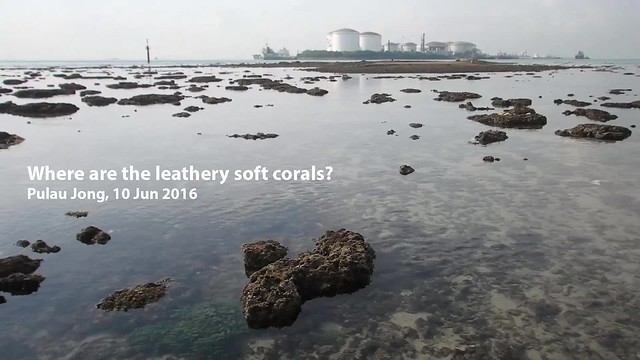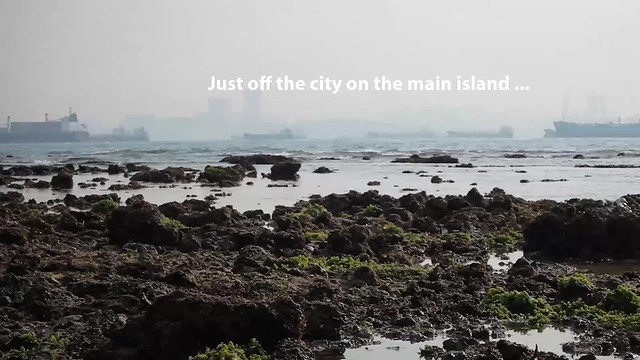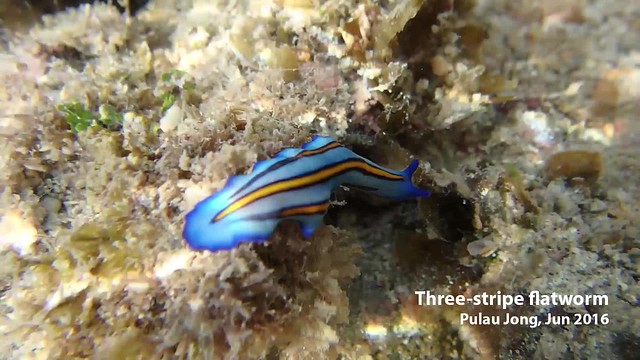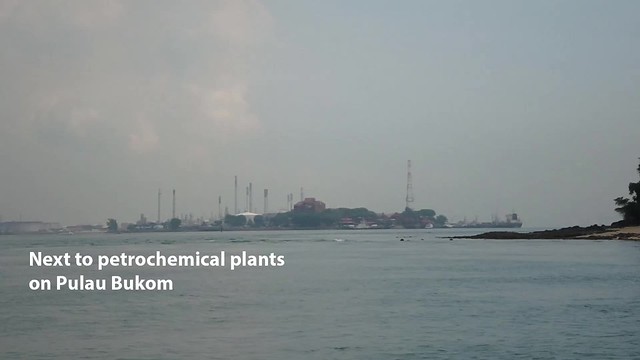About 30-40% of the hard corals and soft corals that I saw on Pulau Jong were bleaching today. As we were arriving I saw many corals in deeper waters bleaching. I also sense that there are much fewer leathery soft corals on the shore than before.
This was not unexpected. From the NOAA's coral reef watch satellite monitoring shows that Singapore is in the Watch zone. Where we should be prepared for mass coral bleaching.
Here's a view of the mass coral bleaching on Pulau Jong. There are not many hard corals on this island.
What is coral bleaching?
Coral are colonies of tiny animals called polyps. Each polyp lives inside a little hard skeleton. The huge colony is made up of the skeletons of countless polyps. Today on Pulau Jong, I only saw one Sandpaper coral and it was bleaching at the tips.
The polyps of all reef-building hard corals harbour microscopic, single-celled algae (called zooxanthellae). The polyp provides the zooxanthellae with shelter and minerals. The zooxanthellae carry out photosynthesis inside the polyp and share the food produced with the polyp. Corals generally have white colour skeletons, which is believed to assist in photosynthensis by reflecting light onto the zooxanthellae.
When there is massive loss of zooxanthellae in a hard coral colony, the polyps become colourless and the underlying white skeleton shows through. Thus patches of the colony appear pale, white or 'bleached'. The polyps are still alive and the hard coral is not dead (yet).
Without the food provided by the lost zooxanthellae, the polyps will be stressed and prone to diseases. Skeleton production and reproduction are also affected. Once the cause of bleaching is removed, however, polyps may eventually regain zooxanthellae (which live freely in the water) and thus recover their health. But prolonged bleaching can kill corals and seriously damage large sections of a reef.
Factors believed to cause bleaching include: temperature fluctuations (too high or too low), excessive exposure to ultraviolet light, excessive sedimentation in the water, changes in salinity and disease. It is generally believed that bleaching is related to unusual prolonged temperature increases in the seawater. Hard corals harbouring zooxanthellae live close to the upper limit of temperature tolerance. Thus a temperature increase of even 1-2 degrees centigrade can redult in bleaching. It is believed that global warming will lead to massive bleaching.
I sense that the reef flat seemed rather barren. With much fewer leathery soft corals than I've seen in the past.
I have often seen leathery soft corals 'melt' and break up into smaller pieces. Is this a response to stress? Is this why there seems to be fewer leathery soft corals on Pulau Jong today?
Not all the leathery soft corals were bleaching.I was surprised to see several colonies of Cauliflower corals that were not bleaching. On the other shores I visited, all the colonies I saw were bleaching.
Similarly, not all the Flowery disk corals I saw were bleaching.
In fact, most of the Disk corals were alright, although a few large ones in deeper water were bleaching.
Many of the Merulinid corals I saw were also alright, with about 30% completely white and bleaching.
I saw a few colonies of these and they were not bleaching: Acropora coral, Pebble coral, Plate montipora coral and Branching montipora coral.
I saw many Small goniopora coral and some Anemone coral colonies and they were not bleaching.
Most of the Boulder pore coral and Branching pore corals I saw were not bleaching, although there were many that were bleaching or pale or pink.
I only saw a few Asparagus corals and they were all bleaching. I saw one corallimorph cluster that was bleaching, while others were not. Some of the Sea mat zoanthids had bleaching patches.
About half of the Frilly anemones I saw were bleaching, the others seemed normal.
During the last mass coral bleaching in 2010, I had similar observations on Pulau Jong. With many corals not bleaching during our quick visit on Aug 2010.
The Mama Fluted giant clam is still there and she is fine! Giant clams can also bleach as they too harbour symbiotic algae and rely on them for food. But I couldn't find the other Fluted giant clam we found on our last survey in Apr 2015. Nor the Merten's carpet anemone we saw on that trip too.
Ian spotted a Tiger-tailed seahorse! There were many many small Blue-spotted fantail rays and the team spotted a shark.
I also saw the pretty Three-striped flatworm as well as some Black Phyllid nudibranchs.
There were sprinkles of Sickle seagrass, with some patches with badly burnt leaf blades.
We did find a fish trap on the high shore but didn't have time to disable it as we rushed off as a thunderstorm gathered nearby.
Dubbed the 'char siew pau' island because of its cute dumpling shape, Pulau Jong has a huge reef flat that is exposed at low spring tide. This reef flat together with the domed island is said to resemble the silhouette of a Chinese sailing junk, thus 'Jong'. Pulau Jong is what all our Southern islands looked like before they were reclaimed. Here's a look at the island as we were leaving today. Let's hope the corals and marine life there make it through the mass coral bleaching.
Pulau Jong is among the existing natural shores that may be impactedby the Land Use Plan following the Population White Paper. Others include Pulau Hantu, Terumbu Pempang Darat, Terumbu Pempang Tengah and Terumbu Semakau.
Today is the last of the super low spring tides and thus we won't be surveying any shores for about two weeks. I hope they stay safe and make it through the mass coral bleaching.
High res photos of mass coral bleaching in Singapore for free download on wildsingapore flickr
Posts shared by others on this trip
Others on this trip: Nick Yap.


























